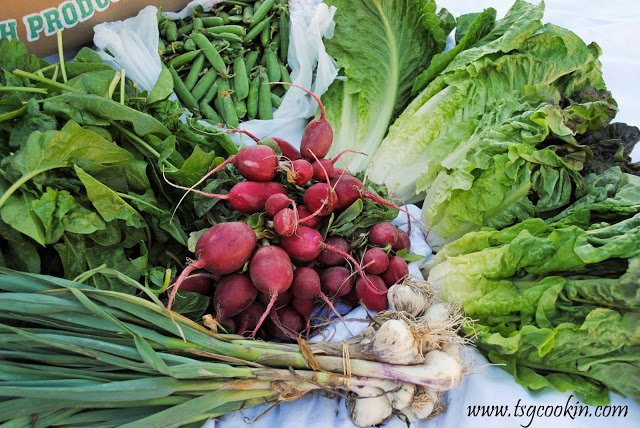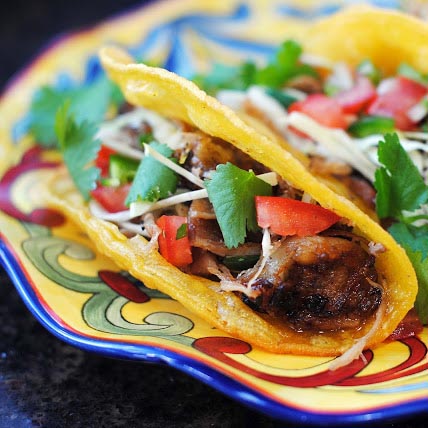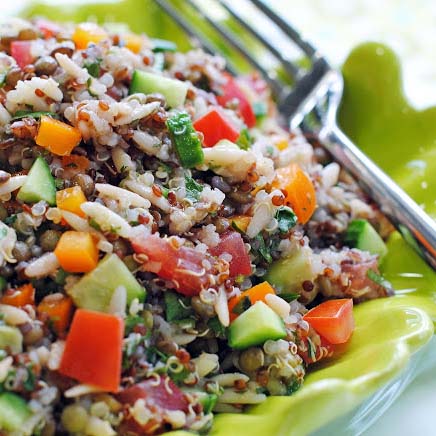I am so excited! My husband and I joined a CSA (Community Supported Agriculture) group recently and got our first produce delivery yesterday. In our box was spinach (2.5 pounds), green garlic (eight bulbs), romaine lettuce (2 heads), red leaf lettuce (2 heads), peas (4 pounds), and radishes (4 bunches).
Spring here has been cold and wet and most gardens are about 3-4 weeks behind where they would normally be at this time. So, getting fresh produce from a local farm is outstanding! It keeps my hopes alive for better days to come.
The following information is from CSA Utah, but is true of CSA in most states:
What is Community Supported Agriculture?
Community Supported Agriculture (CSA) is a way for citizens to directly support farming and farmers in their communities. Members purchase a share of a farm’s produce for the growing season. These shareholders pay their money upfront and in return typically receive a weekly delivery of what is in season at their local farm. The benefits of reduced transportation costs, having a varied local diet, and a direct positive impact on communities are some of the benefits of participating in this process.
Know Your Farmer, Know Your Food
Members that participate in Community Supported Agriculture have an opportunity to talk with the farmer and visit their farm to see how their produce is grown. Many CSA farms allow shareholders to get involved in a variety of field events and gain an understanding of what is involved in growing their food in a way that is often consistent with their values. This active dialogue can increase the quality of the experience of buying and eating fruits and vegetables produced in the ecosystem you live.
Buy Local
There many tangible and intangible benefits associated with buying local products in your local Utah community. Spending your money on locally produced goods and services keeps the community economically viable. Just like the unique character of each CSA farm, economies also benefit from the local flavor of these small businesses. Buying local conserves natural resources, reliance on fossil fuels is greatly reduced due to less shipping requirements. CSA farms do their part to protect the environment, most of these operations incorporate organic or natural methods that work in harmony with nature.
Eat Fresh
The closer you are to your food supply, the shorter the distance it travels to your table and increases the quality and flavor of your favorite fruits, veggies, and other products you enjoy. Eating fresh local produce helps consumers understand how their food is grown. These typically small local farms help preserve the genetic diversity that larger centralized farms cannot.
To find out more about CSA and if there are any CSA farms in your area, check the following links:
Canada has a similar program, Community Shared Agriculture. If you are from Canada, it is best to do an internet search by Province to learn more information.
I would like to encourage everyone to support your local farmers. I have watched the farmland in my area diminish year by year, giving way to more and more housing and commercial developments. It makes me kind of sad.
I have always believed in having a home garden and have loved growing my own vegetables. Some years have been more productive than others, but the offering of each garden has been appreciated. One year I had a garden that was so bountiful that I had to pick it twice a day. It was my magic garden that year, one that was truly blessed by God. I used all of my canning jars that year, probably close to 500 jars, for tomatoes, pickles, beans, pickled beets, etc. I also had more than enough vegetables to share with multiple neighbors who were new to the neighborhood because we lived in a new housing development.
Each year in my vegetable garden I grow many types of tomatoes, beans, cucumbers, summer and winter squashes, peppers, eggplant, and carrots. Other vegetables that I have grown are potatoes, pumpkins, broccoli, onions, peas, and okra. My daughter lives in a town house and doesn’t have space for a traditional garden, but each year she grows tomatoes in large pots on her patio. They are quite productive and give her beautiful fresh tomatoes for snacking and for use in summertime suppers. Her children love to watch as the first tiny tomatoes appear on the vines and wait with anticipation day by day as the tomatoes grow. On the small little 4′ x 3′ patch of ground around her air conditioning unit, Tricia has planted an herb garden. It is shockingly productive with sage, chives, basil, rosemary, oregano, parsley, and thyme. There are several varieties of some of the herbs. What fun!
This year I am planting herbs in pots with the hope of moving the pots indoors for the winter. I have grow lights which can be suspended from the ceiling and my thinking is that the herbs can have a relatively happy home in a corner of my basement. It will be an experiment this winter. I’ll let you know how it works out.





Leave a Reply